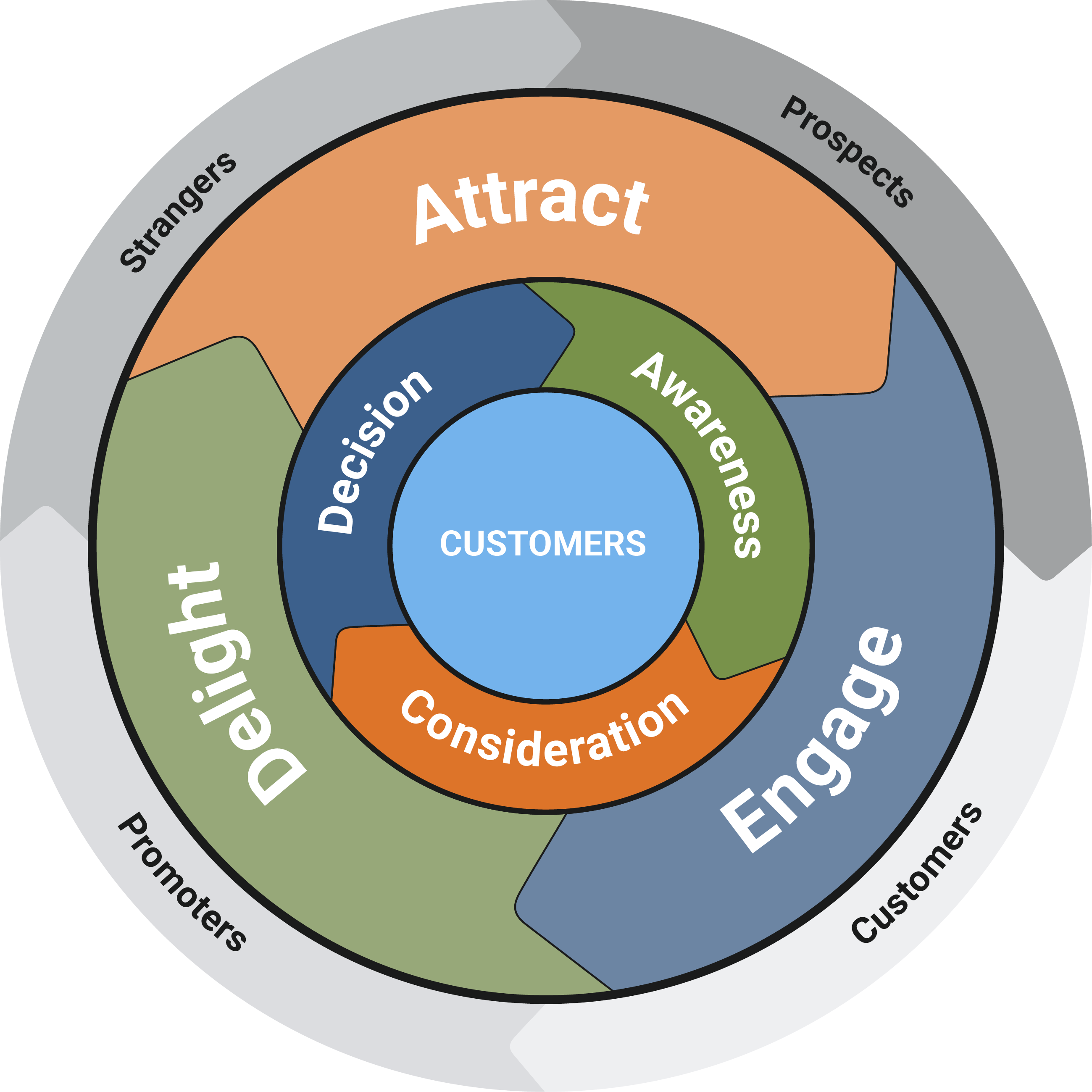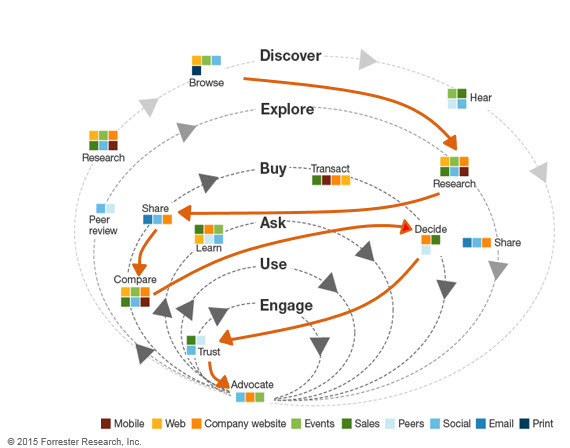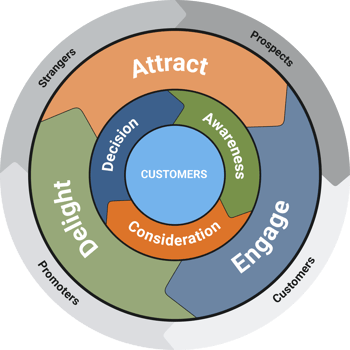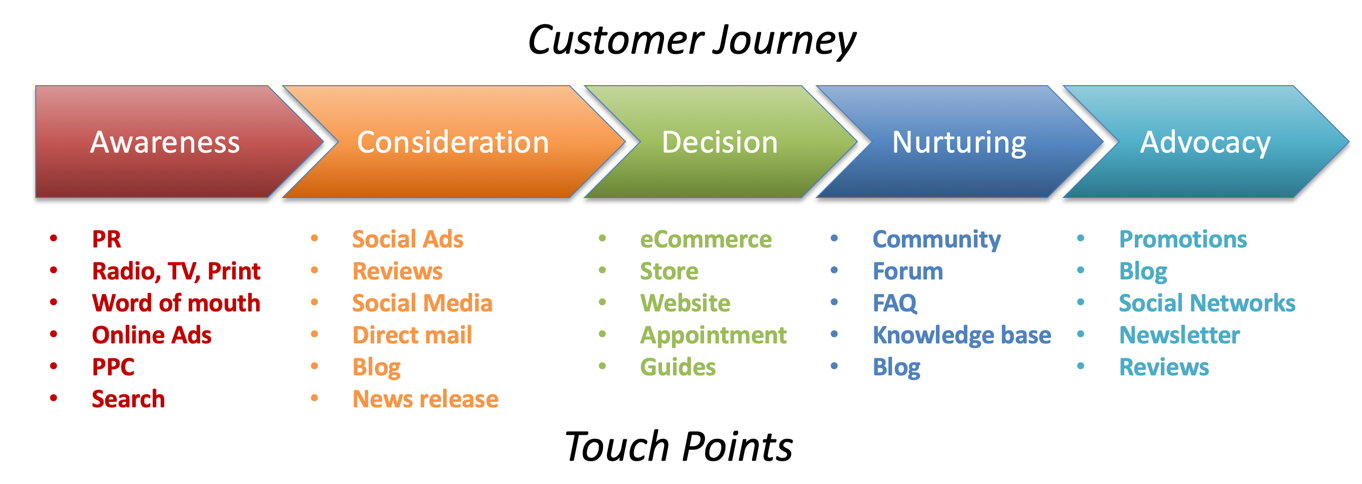
In the old days, the customer journey was a concept few brands had heard of. The interaction between brands and customers often started and finished the moment they walked into a store and made a purchase. Sure, companies have been investing in market-research for over a century, but the modern definition of the customer experience bears little resemblance to what it has become today.
The digital landscape has given rise to the modern concept that is customer experience (CX). Empowered by technology and ever-expectant of instant gratification, customer habits have evolved beyond recognition: social media has become the new word of mouth, online reviews drive purchase decisions across every industry sector, and one blunder on Twitter is enough to bring even the most influential brands to their knees.
The customer journey is complex

Nowadays, brands are facing a wealth of essential technology and marketing trends along with the ever-changing demands of customers. If there’s one thing that isn’t going to change, however, it’s that brands need to maintain a consistent presence from the moment a potential customer first hears about them. That’s why companies need a constantly evolving marketing strategy that aligns perfectly with the customer journey.
No longer can brands focus on addressing one challenge at a time. Instead, their marketing efforts must be consolidated into a single cohesive approach driven by data-based decision-making. This way, there’s no need to miss out on lucrative new opportunities or end up wasting money on dated advertising concepts that just don’t work. That is why we often suggest that brands create an online inbound marketing sales funnel.
More than ever before, a brand’s reputation lies squarely in the hands of its customers. We’ve entered the age of the consumer where one angry review is sometimes all it takes to bring it all tumbling down. Inbound marketing is where it all starts. Rather than investing enormous sums on paid advertisements in an age when banner blindness is in full swing, brands are looking to leverage real and meaningful relationships with their customers. That means using content to build authority, humanizing your brand with social media and building interest using search engine optimization (SEO).
 Inbound marketing doesn’t stop once a prospect becomes a customer. Instead, it starts with awareness with a view to brand advocacy, which is the point at which happy customers spread the good word about your brand. Defining the various stages of the customer journey is where it all starts. Once you understand these stages, it’s time to align your marketing efforts with them and adopt a culture of continuous improvement through data-driven insights and ongoing testing.
Inbound marketing doesn’t stop once a prospect becomes a customer. Instead, it starts with awareness with a view to brand advocacy, which is the point at which happy customers spread the good word about your brand. Defining the various stages of the customer journey is where it all starts. Once you understand these stages, it’s time to align your marketing efforts with them and adopt a culture of continuous improvement through data-driven insights and ongoing testing.
During the Inbound conference last year, Hubspot's Brian Halligan described the way brands should interact with customers as a flywheel. Anyone with knowledge about the mechanical dynamics of a flywheel knows that you need forces to make it spin and friction slows it down.
So, think of all of the good things your brand does for clients as positive forces and mistakes as friction. You want the way the business interacts with the market at every stage to be a positive force.
Each stage, in turn, has multiple steps (and touch points) associated with it, which will help you define the optimal marketing methods to integrate into your strategy. We’ll be exploring these in more detail below.

To raise awareness, you need to be visible in the right places. You need to know where your target audience hangs out and how to make that critical first connection. For this, you need to understand how people find out about brands in your industry when they’re conducting initial research. For example, if someone is looking for a hotel, they might head to TripAdvisor, but if they’re looking to evaluate online services, they might make a beeline for Trustpilot. Digital marketing channels also apply for any traditional bricks-and-mortar business, which consumers are likely to find using mobile mapping apps like Google Maps.
Maintaining an online presence is critical for any business. For local venues, this might involve having your company name, address and phone number (NAP) in local directories and on Google Maps. For digital businesses, it’s essential to maintain high visibility on a wide range of platforms, including social media, search engines, and consumer review sites. For this, you need a strong content strategy that helps build authority, gain recognition and increase visibility in search results and shareability on social media. Furthermore, given the fleeting nature digital content and attention spans, you also need a consistent publishing schedule.
Before digital technologies changed the power dynamic between consumers and businesses, the consideration stage of the customer journey relied heavily on traditional advertising. Word of mouth, naturally, has always been an important driver in decision-making, but the internet has made it exponentially more powerful. Today, customers will rarely just click on a link in a search results page and make a purchase without a second thought. If they haven’t purchased from that company before, chances are they’ll seek out online ratings and reviews or act upon a recommendation from an existing brand advocate.
Many brands dismiss the importance of user-generated content like online reviews because they have no direct control over it. However, the consideration stage is all about reputation management. Sure, you can’t go around expecting just to remove negative feedback and be done with it, but that doesn’t mean you can’t still influence your reputation. For example, many consumers put more weight into how a brand responds to negative feedback than the content of the feedback itself. Ignoring it, on the other hand, is perhaps the worst thing you can do. Your own content and social strategy can also shape purchase decisions by educating people and offering them genuine value, which is something traditional advertising fails to do.

When a potential customer shows a genuine interest in your brand, they become a potential opportunity for sales. While the term primarily applies in B2B relationships, many of the same rules apply in certain B2C industries as well. For example, a member of your target audience might be defined as a lead when they sign up to an email newsletter, subscribe to your business blog or join a trial version of a service. However, it’s important not to focus obsessively on largely meaningless vanity metrics, such as the number of page views or likes on Facebook. Real leads are those who have had had some meaningful interaction with your brand – not those who have just spent two seconds looking at your website before disappearing.
Signing up for an email newsletter is an excellent example of the first step in the acquisition stage. This is your chance to nurture that budding relationship by providing value-adding content that leaves them with the feeling they’ve learned something useful. To capture leads in the first place, you’ll need a benefit-focused landing page that clearly answers the ‘what’s in it for me’ question. If all you have to offer is an endless barrage of product specifications, pushy sales pitches or surface-level commodity content, you’ll only damage your reputation without even acquiring a new customer.
Most businesses recognize the need to influence potential customers from the moment they first hear about the brand. Unfortunately, however, far too many companies still seem to think that the relationship is over from the moment a purchase is made. This is especially likely to be the case in consumer-facing industries, many of which are frequently berated for offering poor customer support. This stage of the journey is your opportunity to make a lasting impression and lay the foundations for brand advocacy – the most critical stage of all.
Some companies think of the nurturing stage as an opportunity to indulge in endless upselling and cross-selling. However, that’s a quick way to frustrate a happy customer and encourage them to leave bad reviews (even if your product itself is great). Instead, nurturing customers is about helping them get the best possible use out of their purchases. Think user guides, tips & tricks articles and online communities where they can share their experiences and advice with other customers. Once you’ve mastered content that nurtures (both branded and user-generated) and customer service, you’ll be well on your way to inspiring advocacy.
Advocates are the most valuable people to your brand, and not necessarily because they’re spending the most money. In fact, when it comes to direct revenue, an advocate might not even net you anything at all. Instead, an advocate is someone with the influence and desire to spread the word. Others respect their decisions and judgments and are more likely to act on their advice and recommendations. It must also be stressed that advocates aren’t paid influencers – they’re simply happy customers who want to share their positive experiences with their friends, family, and followers.
There are many ways for brands to encourage advocacy. Simply offering an excellent product and customer support is half the battle, and things like loyalty programs can also help. One often overlooked method, however, is community-building. More than ever, customers want to be a part of something, which means they want an outlet to share their experiences and passions with others. Online communities, such as customer forums, are where many brand advocates are born, encouraged by other community members, brand representatives and tools like gamification.
Bristol Strategy is a full-funnel inbound marketing agency that helps businesses build highly effective digital strategies that place the customer experience above all else. Give us a call today to learn more about how we can help your business grow. If your ready to drill in to address your customer journey, then please consider scheduling an inbound marketing assessment where we will help you identify the gaps in your customer journey and make recommendations to fix it for more traffic, leads and sales.
Ask us about our unique approach that creates a full-funnel "inbound" engagement model for your business that attracts and converts digitally engaged prospects.